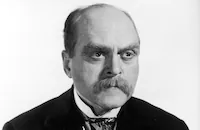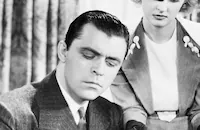Big City Blues

Brief Synopsis
Cast & Crew
Mervyn Leroy
Joan Blondell
Eric Linden
Jobyna Howland
Ned Sparks
Guy Kibbee
Film Details
Technical Specs

Synopsis
Bud Reeves leaves Indiana for New York City expecting never to return to Indiana. His cousin Gibboney meets him at his hotel and, delighted to learn that Bud has a small inheritance, immediately plans a party, to be paid for by Bud. The party is filled with Gibboney's friends and bootleg liquor flows freely. Gibboney introduces Bud to chorus girl Vida Fleet and he is smitten. When two of the guests, Sully and Adkins, start a drunken brawl, one of the women is accidentally killed. The party breaks up quickly as everyone leaves the scene of the crime. House detective Hummell finds the body and sees Vida, who had returned for Bud, leaving the scene. He describes Vida and Bud to the police, who find them after a search at a gambling club, where Bud has lost all his money. The police don't believe Bud's story, but he is cleared when Hummell finds the real killer, Sully, hanging in the broom closet. Released from custody, Bud returns to Indiana, but is not beaten. He intends to save his money and return to New York and Vida.

Director

Mervyn Leroy
Cast

Joan Blondell

Eric Linden
Jobyna Howland

Ned Sparks

Guy Kibbee

Grant Mitchell

Walter Catlett
Inez Courtney
Thomas Jackson

Evalyn Knapp

Humphrey Bogart

Josephine Dunn

Lyle Talbot
Gloria Shea

Sheila Terry
Tom Dugan
Betty Gillette

Edward Mcwade
Crew

Film Details
Technical Specs

Articles
Big City Blues
Surprisingly, the film was a semi-comedy, with most of the humor being provided by veteran actor Walter Catlett, whose performance garnered praise from the critics, such as Mordaunt Hall in The New York Times, who wrote that "Big City Blues, is in most respects an inviting film and the only pity is that Eric Linden's portrayal of a country bumpkin is far from convincing. Mr. Linden makes the young man, who is known as Bud Reeves, too silly to be at liberty alone. There is, however, little doubt that Gotham deserves the scolding it gets here, for there is an element of truth about the incidents. Walter Catlett plays a man named Gibboney, Reeves's New York cousin. This clever comedian runs away with the acting laurels. He has more to say and do than he has had in any other feature and he affords a great deal of amusement. It is a pleasure to witness the scenes in which Mr. Catlett appears and quite painful to observe Mr. Linden's impersonation."
Time Magazine found fault with the screenplay. "The story itself, about a country boy (Eric Linden) who comes to New York to set the town on fire and goes home with scorched fingers, might have been much better handled. Ward Morehouse, who wrote it, is a theatrical reporter who knows more about how theatrical people talk than he does about writing plays. His picture is really a "color story" rather than the melodrama which it sometimes attempts to be or the soft satiric comedy which it could have been. The slight romance between Linden and a kind-hearted chorus girl (Joan Blondell); his association with a gay and amazingly unresourceful confidence man (Walter Catlett); the bravado of his return to Willow Creek are incidents which a more astute playwright might have been able to develop without recourse to such familiar props of metropolitan melodrama as a slain chorus girl, a gimlet-eyed detective on the wrong track. Linden gulps so hard throughout Big City Blues that he succeeds in swallowing his part".
These reviews did nothing to help Eric Linden's career. He had come to Hollywood from the Broadway stage the year before, and at the age of 23 was put into juvenile roles. Soon he was appearing in mostly B pictures. His penultimate film was a bit role in Gone with the Wind (1939) in which he was memorable as a soldier whose leg is amputated.
If the critics were not pleased with Big City Blues, neither was Joan Blondell's father. According to Matthew Kennedy in his biography of Blondell, "She played Vida, a seasoned New York gold digger bemoaning the Depression. 'Chorus girls used to get pearls and diamonds,' she says wearily. 'Now all they expect is a corned beef sandwich.' With an older woman preying on a younger man and a quotation from the Sapphic novel The Well of Loneliness, Big City Blues was objectionable to many. At home, Joan patiently listened to the complaints of her increasingly cranky sixty-seven-year-old father, who voiced disapproval that his daughter was playing so many low women in movies like Big City Blues".
Director: Mervyn LeRoy
Screenplay: Ward Morehouse, Lillie Hayward, based on the play New York Town
Cinematography: James Van Trees
Art Direction: Anton Grot
Music: Ray Heindorf, Bernhard Kaun
Film Editing: Ray Curtiss
Cast: Joan Blondell (Vida Fleet), Eric Linden (Bud Reeves), Jobyna Howland (Mrs. Serena Cartlich), Ned Sparks (Mr. 'Stacky' Stackhouse), Guy Kibbee (Hummell), Grant Mitchell (Station Agent), Humphrey Bogart (Shep Adkins).
BW-63m.
by Lorraine LoBianco
SOURCES:
The New York Times: Walter Catlett Affords Good Fun in Big City Blues, the New Film at the Winter Garden by Mordaunt Hall, September 10, 1932
Joan Blondell: A Life Between Takes by Matthew Kennedy
Time Magazine: Cinema: The New Pictures September 19, 1932
The Internet Movie Database

Big City Blues
Quotes
Trivia
The play, "New York Town" was copyrighted in 1932, but had no known performances.
Miscellaneous Notes
Released in United States 1932
Released in United States 1932














